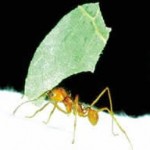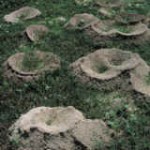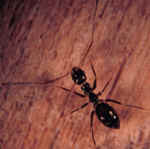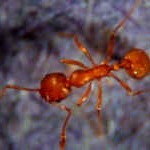Express-News
GARDENING, Etc.
Sunday, January 19, 2003
by Nathan Riggs, IPM Agent-Texas Cooperative Extension, Bexar County
In San Antonio and South Texas, not a warm day goes by without the familiar buzzing of a busy honeybee, annoying housefly or pesky gnat. That’s just normal routine-swatting bugs and the like–on a typical spring or summer day. But what happens in fall and winter? Let’s look at the possibilities for this scenario.
Because normal South Texas winters are comparatively mild, local insects have adapted themselves to a hibernation pattern where they will awaken on warm days and “sleep” on the cold ones. Even at temperatures as low as 50F, female mosquitoes are actively seeking warm-blooded hosts from which to take a blood meal. Granted, these cold weather mosquitoes are not the same species as our vicious warm weather types, but they are active nonetheless.
Leaf Cutter Ants: Habit and Habitat
- Photo from www.harunyahya.com
- Photo Texas Cooperative Ext
- Crazy Ants Photo by Bart Drees, Texas Cooperative Extension
- Pharoah or “Sugar” Ant Photo by Bart Drees, Texas Cooperative Extension
- Carpenter Ant (Kentucky Cooperative Extension)
Many species of ants are active during the winter. Outdoors, the most active ants in winter seem to be leaf cutter ants. They strip vegetation from plants ranging from evergreens, to trees, to ball moss– yes, ball moss! This author has personally observed leaf cutter ants carrying ball moss bits down a tree trunk on a November morning while deer hunting. Leaf cutter ants are nearly impossible to control. Treat the trails as they appear with any dust insecticide approved for ants. Other ants, such as fire ants, are only active on warm, sunny days and are not as much of a concern.
Indoors, sugar ants and crazy ants are a real nuisance during the winter. These ants actively seek water and sugars to survive the winter. Being indoor species, these ants will feed on proteins and greasy or oily foods as well. For both of these ants, a bait containing sugars or sugar liquids will provide the best results. A homemade bait containing 2 teaspoons boric acid, 1/4 cup hot water and 1 cup of corn syrup will do very nicely. Place small amounts of the bait in bottle or jar lids and then place these containers near ant trails for the best results. Keep the bait moist and it will remain attractive to the ants.
Even grasshoppers can survive our winters. They hide in dense grass, bushes and leaf litter to find warmth and stay alive. They will become active when temperatures rise above 60F.
Many folks with sheds or barns are finding large populations of hibernating wasps and ladybugs. Hibernating wasps usually remain so until the weather consistently stays above 65to 70F. Finding those groups of hibernating wasps also provides an opportunity for controlling or relocating them as preferences permit.
Lady bugs are the same way. One local species hibernates in homes, buildings and any sheltered area it can find. On warm winter days, the ladybugs awake and fly around for a few hours.
Insects suit themselves to the best possible environments to ensure their survival and that of their potential future generations. Whether the shelter is natural or man-made, there are plenty of places for insects to hide and wait for warmer weather.
For a copy of the homemade ant bait recipe, log on to the internet and go to http://bexar-tx.tamu.edu/IPM/Household/F1/homeantbait.htm. This address is case sensitive, so pay attention to the capitalization to prevent errors.




